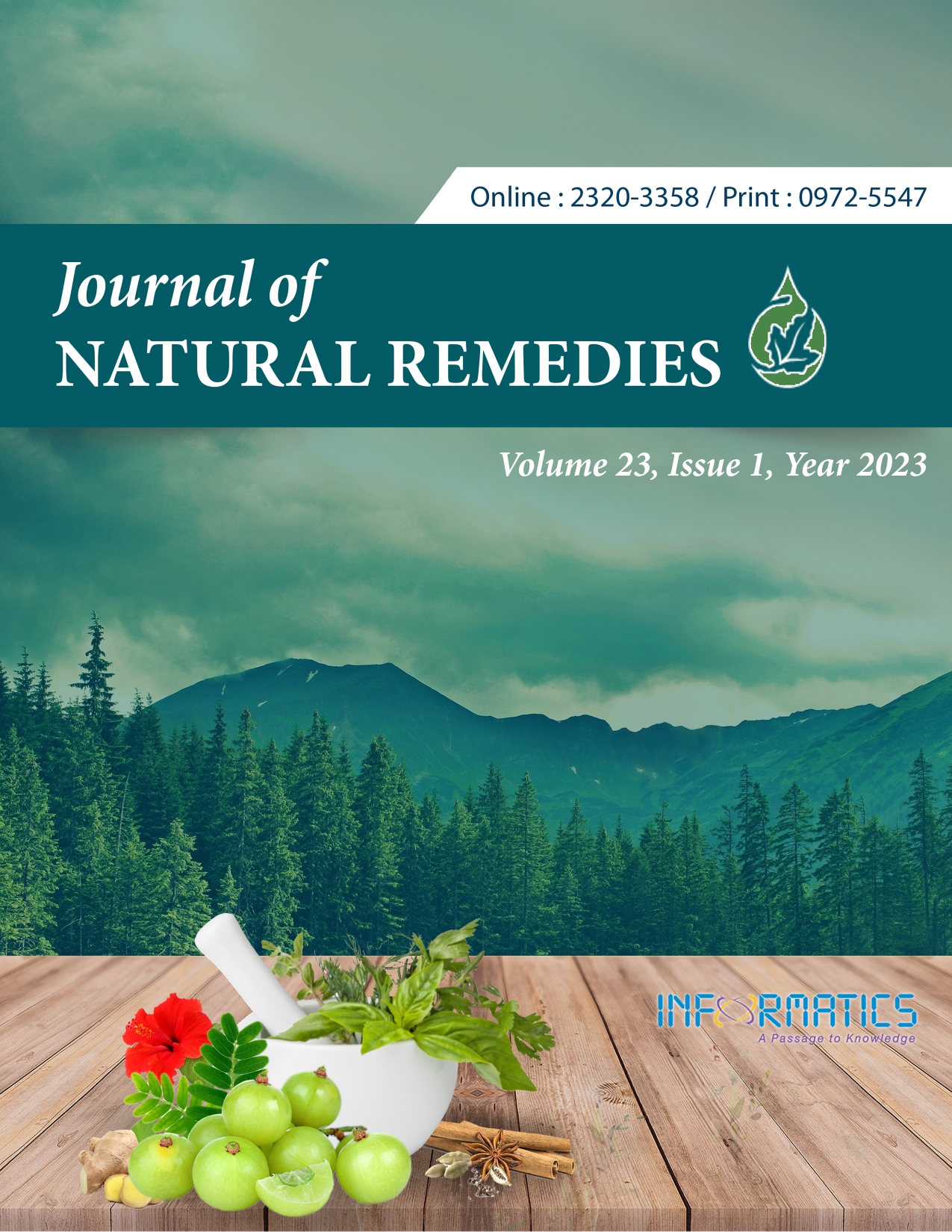Simultaneous Quantification of Piperine, Vasicine and Eugenol in Kabasura Kudineer by HPTLC
DOI:
https://doi.org/10.18311/jnr/2023/31918Keywords:
Cold, COVID-19, Decoction, Fever, Kabasura Kudineer Choornam, Respiratory Tract Infections.Abstract
Kabasura Kudineer is a polyherbal decoction of the Siddha medical system (an Indian system of medicine), traditionally used to cure fever, colds, coughs, and respiratory ailments. The government of India had recommended Kabasura Kudineer as one of many preventive/treatment measures for COVID-19. Kabasura Kudineer Choornam is an admixed coarse powder of 15 herbs and its decoction is Kabasura Kudineer. The chemical constituents in the 15 herbs used for the preparation of the Choornam are known but the constituents present in the Kabasura Kudineer (decoction) are unidentified. Piperine, vasicine and eugenol are known for their potent activity against respiratory tract infections; hence, they were selected as marker compounds. The present work was planned to simultaneously quantify piperine, vasicine and eugenol in Kabasura Kudineer by the HPTLC method. The optimised mobile phase was toluene: ethyl acetate: methanol: ammonia (5:9:3:0.5, v/v/v/v), and the scanning was carried out at 287 nm. The Rf values of piperine, vasicine and eugenol were found to be 0.70, 0.32 and 0.82, respectively. The linearity range of piperine and vasicine was 500-3000 ng spot–1 and it was 10–60 ng spot–1 for eugenol. The quantities of piperine, vasicine and eugenol in Kabasura Kudineer (100 mL) were 0.03, 0.056 and 0.035 % w/v, respectively. This developed method can be used to simultaneously quantify piperine, vasicine and eugenol in any polyherbal formulation.
Downloads
Metrics
Published
How to Cite
Issue
Section
License
Copyright (c) 2023 M. K. Mohan Maruga Raja, Drashti C. Patel (Author)

This work is licensed under a Creative Commons Attribution 4.0 International License.
Accepted 2023-04-12
Published 2023-03-23
References
Devarajan A, Mohanmarugaraja MK. A comprehensive review on Rasam: A South Indian traditional functional food. Pharmacogn Rev. 2017; 11(22):73–82. http://dx.doi. org/10.4103/phrev.phrev_13_17 DOI: https://doi.org/10.4103/phrev.phrev_13_17
The Siddha Formulary of India, Part I. Department of Health and Family Welfare, Government of India. 1983; 287-331.
AYUSH. Guideline for Siddha Practitioners for COVID19 Patients in Home Isolation, 2021. Cited from https:// www.ayush.gov.in/docs/Guidelines%20for%20Siddha%20 Practitioners%20for%20Home%20isolation%20COVIDCCRS_26April2021.pdf
Murugesamudaliyar KS. Siddha Materia Media (Medicinal Plants Division). 8th ed. Chennai, India: Directorate of Indian Medicine and Homeopathy. 2006; 7-713.
NHP. National Health Portal. 2016. Cited from https:// www.nhp.gov.in/swine-flu_mtl
Mekala P, Gopala Krishna Murthy TR. Phytochemical screening and pharmacological update on Kabasura Kudineer Choornam and Nilavembu Kudineer Choornam. J Pharmacogn Phytochem. 2020; 9(3):1031-1036. http:// dx.doi.org/10.22271/phyto.2020.v9.i3q.11428
Khawas S, Nosalova G, Majee SK, Ghosh K, Raja W, Sivova V, Ray B. In vivo cough suppressive activity of pectic polysaccharide with arabinogalactan type II side chains of Piper nigrum fruits and its synergistic effect with piperine. Int J Biol Macromol. 2017; 99:335-342. http://dx.doi. org/10.1016/j.ijbiomac.2017.02.093 DOI: https://doi.org/10.1016/j.ijbiomac.2017.02.093
Liang YD, Bai WJ, Li CG, Xu LH, Wei HX, Pan, H, et al. Piperine Suppresses Pyroptosis and Interleukin-1β Release upon ATP Triggering and Bacterial Infection. Front Pharmacol. 2016; 7:390. http://dx.doi.org/10.3389/ fphar.2016.00390 DOI: https://doi.org/10.3389/fphar.2016.00390
Ulanowska M, Olas B. Biological properties and prospects for the application of eugenol-A review. Int J Mol Sci. 2021; 22(7):3671. http://dx.doi.org/10.3390/ijms22073671 DOI: https://doi.org/10.3390/ijms22073671
Vicidomini C, Roviello V, Roviello GN. Molecular basis of the therapeutical potential of clove (Syzygium aromaticum L.) and clues to its anti-COVID-19 utility. Molecules. 2021; 26(7):1880. http://dx.doi.org/10.3390/molecules26071880 DOI: https://doi.org/10.3390/molecules26071880
Barth A, Hovhannisyan A, Jamalyan K, Narimanyan M. Antitussive effect of a fixed combination of Justicia adhatoda, Echinacea purpurea and Eleutherococcus senticosus extracts in patients with acute upper respiratory tract infection: A comparative, randomized, double-blind, placebo-controlled study. Phytomedicine. 2015; 22(13):1195-1200. http://dx.doi.org/10.1016/j.phymed.2015.10.001 DOI: https://doi.org/10.1016/j.phymed.2015.10.001
Kumari N, Akhtar J, Ahmad M, Badruddeen, Irfan Khan M. An outline on vasicine, its ethnomedical and nanoformulation approach. J Biol Act Prod Nat. 2021; 11(1):42-59. http://dx.doi.org/10.1080/22311866.2021.1886990 DOI: https://doi.org/10.1080/22311866.2021.1886990
Mohan Maruga Raja MK, Patel RS, Mishra SH. Identification and quantification of adrenaline from the leaves of Clerodendrum phlomidis using thin-layer chromatography. Zhong Xi Yi Jie He Xue Bao. 2011; 9(1):105-8. https://doi. org/10.3736/jcim20110117 DOI: https://doi.org/10.3736/jcim20110117
Raja MM, Mishra SH. Quantification of L-DOPA, lupeol and beta-sitosterol from leaves of Clerodendrum phlomidis by TLC. Herba Pol. 2009; 55(4):44-51.

 M. K. Mohan Maruga Raja
M. K. Mohan Maruga Raja









 0.35
0.35 24
24 0.161
0.161